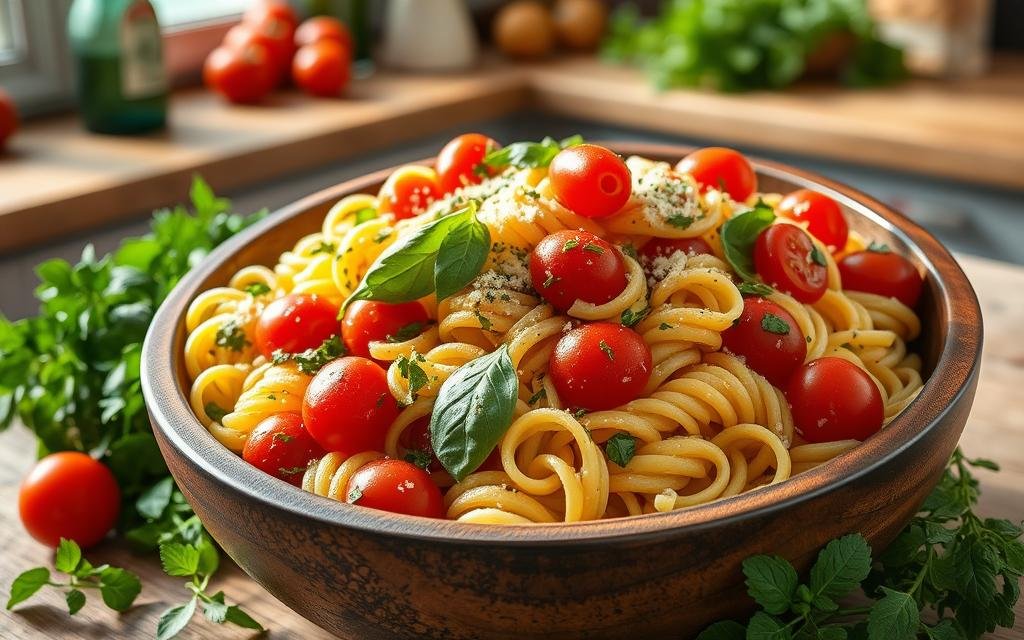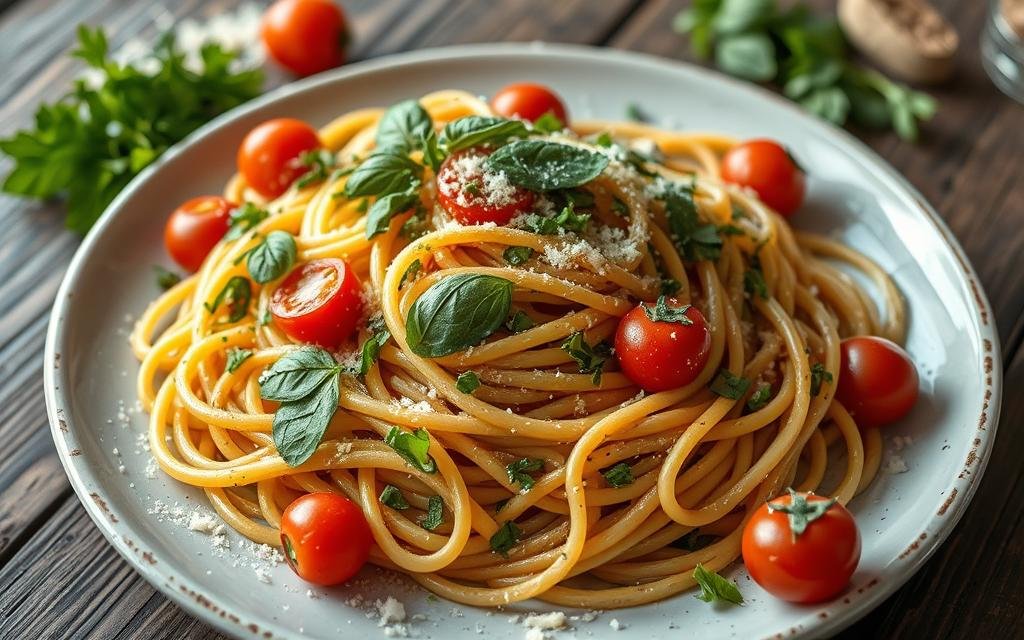Close your eyes and imagine the aroma of fragrant herbs mingling with perfectly cooked pasta. That’s the magic of Italian herb pasta, a dish that’s about to become your new obsession. Growing up in a family that loved Italian food, I can tell you this recipe is a game-changer.
This italian herb pasta recipe is a treat. It’s not just a meal; it’s a journey through the heart of Italian cuisine. The mix of fresh herbs and al dente pasta creates a symphony of flavors. It will take you straight to a cozy trattoria in Rome.
Get ready to dive into a world where pasta recipes reign supreme and Italian food is king. This dish isn’t just delicious; it’s a celebration of simple ingredients transformed into something extraordinary. Let’s embark on this culinary adventure together!
Discovering the Magic of Italian Herb Pasta
Italian herb pasta is a favorite in many homes. Its rich flavors and herbs make it loved by food lovers everywhere.
The Origins of Italian Herb-Infused Dishes
Italian food has always included herbs in pasta. The ancient Romans started this tradition. Over time, these dishes became a big part of Italy’s food culture.
Why Italian Herb Pasta is a Crowd Favorite
Italian herb pasta is loved for its versatility. It’s great for a quick dinner or a fancy meal. Its ability to pair with many sauces makes it a favorite among cooks.
Key Ingredients That Make It Special
The secret to italian herb pasta is its ingredients. Basil, oregano, and thyme are key. Garlic and olive oil add to the flavor. The pasta, made from durum wheat semolina, holds it all together.
“In the realm of Italian cuisine, herbs are not just ingredients; they’re the soul of the dish.”
Italian Herb Pasta Recipe: A Step-by-Step Guide
Ready to make a delicious italian herb pasta recipe? This dish is sure to become a favorite in your pasta collection.
First, get your ingredients ready: pasta, olive oil, garlic, dried Italian herbs, fresh basil, Parmesan cheese, and salt. For the sauce, you’ll need crushed tomatoes, oregano, and a bit of red pepper flakes.
Start by boiling salted water and cooking your pasta until it’s al dente. While it cooks, heat olive oil in a pan and sauté minced garlic until it smells great. Then, add the crushed tomatoes and dried herbs, and simmer for 10 minutes.
Drain the pasta, keeping a cup of pasta water aside. Toss the pasta with the sauce, adding pasta water if it’s too thick. Mix in fresh basil and grated Parmesan.
“The secret to perfect Italian herb pasta is in the balance of flavors and textures,” says renowned chef Mario Rossi.
For a creamy twist, add a bit of heavy cream to your sauce. Vegetarians can use plant-based cheese instead. Try different herbs to find your favorite mix.
Serve your Italian herb pasta hot, topped with extra basil and Parmesan. Enjoy it with a crisp salad and crusty bread for a full meal. Buon appetito!
Customizing Your Italian Herb Pasta Experience
Italian herb pasta is very flexible. It can fit many diets and events. Let’s see how to make it your own.
Vegetarian and Vegan Options
It’s simple to make a tasty vegetarian pasta. Just skip the meat and add colorful veggies like bell peppers and zucchini. For vegans, use nutritional yeast for a cheesy taste.
Try an italian herb pasta salad with olives and sun-dried tomatoes for a Mediterranean flavor.

Pairing Suggestions for the Perfect Meal
Pair your pasta with a crisp white wine like Pinot Grigio or a light red like Chianti. A fresh green salad or garlic bread is a great side. For a full meal, add grilled veggies or a caprese salad.
Making It Ahead: Storage and Reheating Tips
Make your italian herb pasta salad ahead for quick meals. Store it in a sealed container in the fridge for up to 3 days. When reheating, add a bit of water or broth to keep it moist.
For cold pasta salads, let them warm up to room temperature before serving. This brings out the flavors.
“The beauty of Italian cuisine lies in its simplicity and flexibility. Don’t be afraid to experiment with your pasta dishes!”
Elevating Your Italian Cooking Skills
Mastering Italian recipes requires practice and knowledge. To improve your pasta dishes, focus on getting the pasta just right. It should be firm but not hard, then finish it in the sauce. This way, the pasta soaks up the flavors without losing its texture.
Timing is key when using herbs. Add delicate herbs like basil at the end to keep their flavor fresh. Strong herbs like rosemary can go in earlier to add depth. Try different mixes to find your favorite Italian herb blend.
“The secret to great Italian cooking lies in respecting the ingredients and letting their natural flavors shine,” says renowned chef Massimo Bottura.
To get better at Italian cooking, balance your flavors. A bit of lemon juice or vinegar can make a rich dish pop. Salt is crucial for enhancing your ingredients. Remember, cooking is an art. Trust your taste and adjust as needed.
Finally, choose the best ingredients. Fresh tomatoes make a huge difference in sauces. Use extra virgin olive oil for its strong taste and authentic Italian cheeses. With these tips, you’ll soon be making bellissimo Italian dishes!
Similar Italian Recipes You Will Love
If you’ve fallen for our Italian herb pasta, you’ll love these other classic pasta recipes. Cacio e Pepe, a Roman favorite, combines black pepper and Pecorino Romano cheese. It’s a simple yet flavorful dish that shows the beauty of Italian food.
Pasta Primavera is a vibrant dish with seasonal vegetables and a light cream sauce. It’s perfect for when you want something fresh and colorful. It’s a great choice for a lighter Italian meal.
Craving something rich and creamy? Fettuccine Alfredo is your answer. It has a velvety sauce made from butter and Parmesan cheese. It’s a true comfort food that shows the heartiness of Italian cuisine.
These pasta recipes take you on a delicious journey through Italy’s culinary landscape. Each dish brings unique flavors and textures. Try them and find new favorites in the world of Italian food!
Conclusion
Italian herb pasta is a true reflection of Italy’s rich culinary heritage. It’s a dish that perfectly combines flavors, making every bite a delight. By learning this recipe, you unlock a world of Italian flavors.
Your kitchen will become a place filled with the scents of herbs and spices. This recipe is great because you can try new things. Mix different herbs or add your favorite veggies to make it your own.
Quality ingredients are key to making great Italian food. Use the best olive oil and Parmesan cheese you can find. These touches make your pasta truly special.
Cooking is like love. It should be entered into with abandon or not at all.
This quote really gets to the heart of Italian cooking. Enjoy the process, the smells, and every taste. This herb pasta recipe is just the start of your Italian food adventure. It will inspire you to make many more delicious meals for your family and friends.
FAQ
What are the key ingredients in the Italian herb pasta recipe?
The recipe includes pasta like linguine or fettuccine. It also has garlic, olive oil, and fresh herbs like basil and parsley. You’ll need Parmesan cheese and spices too.
Can I make this recipe vegetarian or vegan?
Yes, it’s easy to make this recipe vegetarian or vegan. Just skip the Parmesan cheese or use a vegan version. Make sure the pasta you pick doesn’t have eggs.
How can I customize the flavor of the Italian herb pasta sauce?
This recipe is all about trying new things. Mix up the herbs, add red pepper flakes for spice, or try sun-dried tomatoes or olives for a salty taste.
Can I make this dish ahead of time?
Definitely! It’s great for meal prep. Cook the pasta, mix it with the sauce, and chill it until you’re ready. When you reheat, add some pasta water to make the sauce smooth again.
What wine pairs well with this Italian herb pasta dish?
A crisp white wine like Pinot Grigio or Sauvignon Blanc goes well with the herbs. For red, a light Chianti or Montepulciano works well.
How can I take my Italian cooking skills to the next level?
To get better at Italian cooking, focus on flavor balance and seasoning. Learn to cook pasta just right. Try new herbs and spices, and add your own twist to classic dishes.

